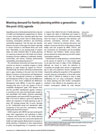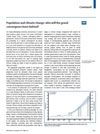-
Addressing Reproductive Health and Rights in a Post-MDG World Begins With Inequality
July 23, 2014 By Sarah Meyerhoff The importance of reproductive health and rights in responding to global climate change and facilitating sustainable development is becoming increasingly clear. But as two articles recently published in The Lancet explain, any post-Millennium Development Goals development agenda that hopes to address these issues must do a better job reaching populations that have largely been excluded from recent advancements.
The importance of reproductive health and rights in responding to global climate change and facilitating sustainable development is becoming increasingly clear. But as two articles recently published in The Lancet explain, any post-Millennium Development Goals development agenda that hopes to address these issues must do a better job reaching populations that have largely been excluded from recent advancements.The importance of reproductive health and rights in responding to global climate change and facilitating sustainable development is becoming increasingly clear. But as two articles recently published in The Lancet explain, any post-Millennium Development Goals development agenda that hopes to address these issues must do a better job reaching populations that have largely been excluded from recent advancements.
 In a commentary piece, Director of USAID’s Office of Population and Reproductive Health Ellen Starbird and her colleagues push the international community to set the bar higher in their efforts to expand access to family planning. Family planning advocates should strive to meet 75 percent of demand for modern contraceptives – the level currently met across OECD countries – in every country by 2030, they write. Doing so requires better efforts to ensure equality of access in developing countries that have lagged behind in providing reproductive health services. Across low-income countries, the demand met for modern contraceptives is 50 percent higher among the top wealth quintile than all wealth quintiles combined. The Family Planning 2020 goal – extending access to modern contraceptive methods to 120 million more women in the 69 least developed countries by 2020 – is an integral step in closing this gap, they write, but they also suggest advocates need to go further, expanding the definition of “family planning demand.” They hope that measurements of demand will soon encompass all women who are sexually active and seek access to contraceptives, rather than just those who are married or partnered.
In a commentary piece, Director of USAID’s Office of Population and Reproductive Health Ellen Starbird and her colleagues push the international community to set the bar higher in their efforts to expand access to family planning. Family planning advocates should strive to meet 75 percent of demand for modern contraceptives – the level currently met across OECD countries – in every country by 2030, they write. Doing so requires better efforts to ensure equality of access in developing countries that have lagged behind in providing reproductive health services. Across low-income countries, the demand met for modern contraceptives is 50 percent higher among the top wealth quintile than all wealth quintiles combined. The Family Planning 2020 goal – extending access to modern contraceptive methods to 120 million more women in the 69 least developed countries by 2020 – is an integral step in closing this gap, they write, but they also suggest advocates need to go further, expanding the definition of “family planning demand.” They hope that measurements of demand will soon encompass all women who are sexually active and seek access to contraceptives, rather than just those who are married or partnered. In Population and Climate: Who Will the Global Convergence Leave Behind?, Martha Campbell et al. explore the successes and limitations of reproductive health efforts in the Sahel, the band of semi-arid land that marks the transition between the Saharan Desert and southern Africa. More than 40 percent of the population in this region is under 15 and average temperatures may increase as much as 8°C by 2100, they write. Those with the least access to family planning options – farmers and pastoralists – are also under the greatest pressure from a changing climate. As fertility rates remain high and temperatures rise, these groups will be particularly vulnerable to malnutrition, infection, and other climate-related health issues, threatening to fall even further behind in health outcomes. “Interventions must be developed in a human rights framework,” they write, “ensuring that the benefits do not drift only toward those with the most social and political capital.” To improve resilience, they suggest Sahelian governments and international donors couple family planning interventions with climate adaptation programs and women’s empowerment campaigns for at-risk groups.
In Population and Climate: Who Will the Global Convergence Leave Behind?, Martha Campbell et al. explore the successes and limitations of reproductive health efforts in the Sahel, the band of semi-arid land that marks the transition between the Saharan Desert and southern Africa. More than 40 percent of the population in this region is under 15 and average temperatures may increase as much as 8°C by 2100, they write. Those with the least access to family planning options – farmers and pastoralists – are also under the greatest pressure from a changing climate. As fertility rates remain high and temperatures rise, these groups will be particularly vulnerable to malnutrition, infection, and other climate-related health issues, threatening to fall even further behind in health outcomes. “Interventions must be developed in a human rights framework,” they write, “ensuring that the benefits do not drift only toward those with the most social and political capital.” To improve resilience, they suggest Sahelian governments and international donors couple family planning interventions with climate adaptation programs and women’s empowerment campaigns for at-risk groups.Sources: The Lancet.
Topics: Africa, climate change, development, family planning, global health, population, Reading Radar, Sahel, USAID
 A Publication of the Stimson Center.
A Publication of the Stimson Center.





